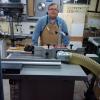Im building a 44 tall maple/steel standing desk with steel H frame legs (photo below) that measure out to be 39.25 tall and 24 wide. Legs are made out 1.5x1.5 steel tube.
The table top will be 48 x 28 x 1.75 maple butcher block top and there will also be a 1.25 maple panel/lower shelf fastened to the lower leg rails. Lastly, legs will be on 2-3 casters.
So my question- Is there any potential for racking with the legs being so tall or will the fastened table top and lower shelf prevent that? I might also be adding drawers under the table making it further top heavy.
Any input is appreciated!
Screen Shot 2020-04-09 at 8.32.12 PM.jpg




 Reply With Quote
Reply With Quote
 If you look at adjustable standing desks, you'll see that most only have a single legs on each side - between that and whatever slop exists in the raise/lower mechanism, they're still stiff enough. So in your case, I definitely wouldn't worry.
If you look at adjustable standing desks, you'll see that most only have a single legs on each side - between that and whatever slop exists in the raise/lower mechanism, they're still stiff enough. So in your case, I definitely wouldn't worry.


